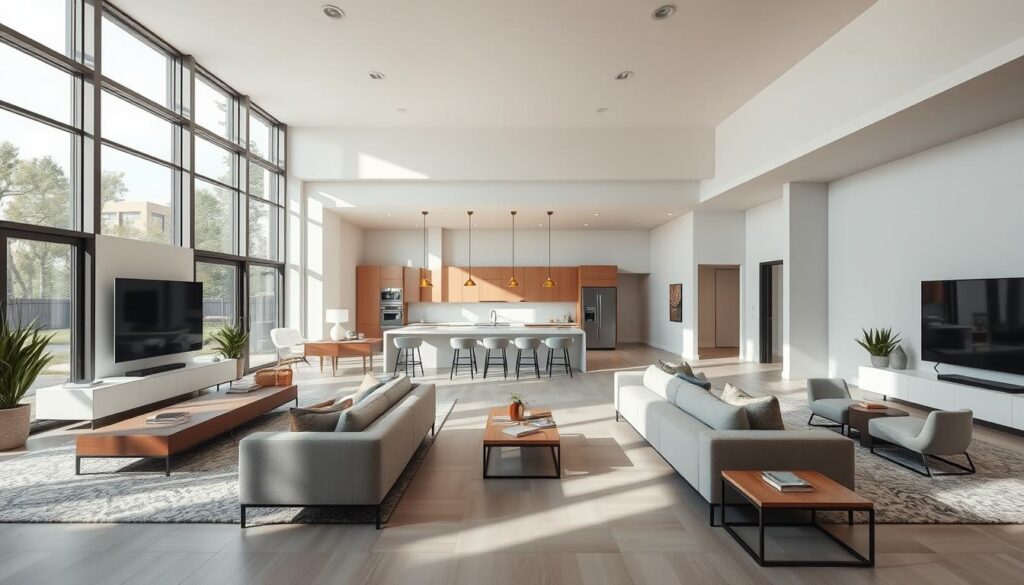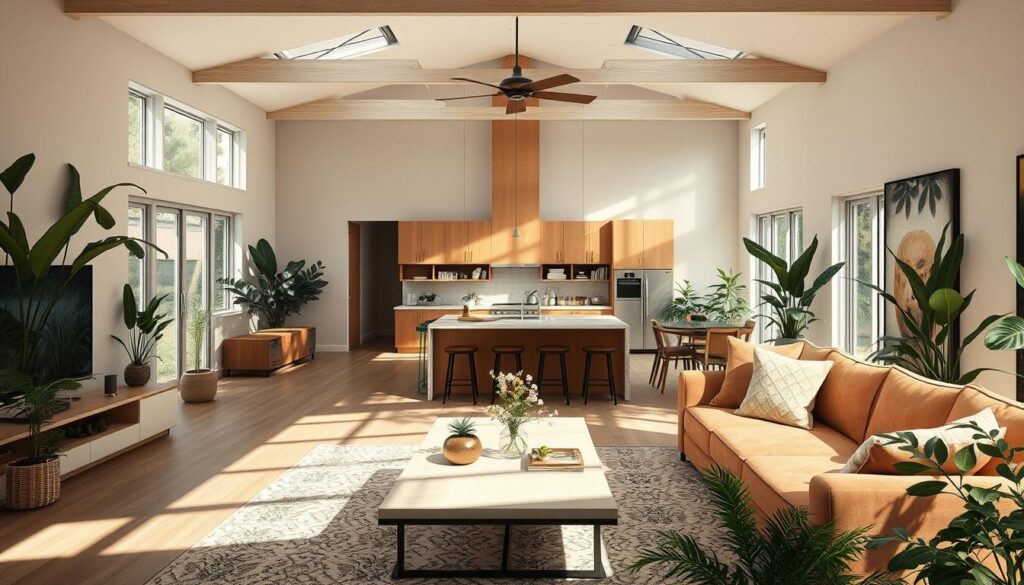How Many Rooms Can Fit in 2000 sq ft?
Get Your Free Moving Estimate
Determining how many rooms can fit in 2000 sq ft is a common inquiry for homeowners and prospective tenants alike. Understanding room capacity within this square footage can significantly influence your decision-making process regarding home layouts. By effectively utilizing square footage occupancy, you can optimize living arrangements to enhance comfort and functionality. This exploration sets the stage for an in-depth discussion on maximizing space, ensuring that every square foot serves a purpose.
Key Takeaways
- Understanding the impact of square footage on room capacity.
- Strategies for optimizing living arrangements in a 2000 sq ft space.
- The importance of thoughtful layout design for comfort and efficiency.
- How to balance room count with functionality and design.
- Considering individual needs when assessing space utilization.
Understanding Square Footage
Understanding square footage is essential for anyone involved in real estate or home design. This measurement provides a foundation for how we think about living spaces and their utility. Knowing square footage allows homeowners and designers to make informed decisions about how to utilize available space effectively.
What is Square Footage?
Square footage refers to the total area of a building or space, expressed in square feet. This measurement includes all usable areas such as bedrooms, living rooms, kitchens, and bathrooms. Understanding this metric allows homeowners to assess property values and compare different homes on the market. It helps define the overall layout and functionality of a residence, impacting both livability and aesthetic appeal.
Importance of Square Footage in Home Design
In home design, square footage is crucial for optimizing space utilization. Designers must consider how each room serves its purpose while maximizing the available area. A well-planned space enhances daily interactions, comfort, and overall satisfaction with a home. Paying attention to square footage ensures that every square foot contributes to the functionality and beauty of the living environment.
By grasping the concept of square footage, we align our expectations with actual living conditions, leading to better decision-making in both home purchases and design ventures.
Factors Affecting Room Size
Understanding the factors affecting room size is crucial for optimal design and functionality. Different spaces within a home serve distinct purposes, with each impacting the average room dimensions. Tailoring the dimensions to match the room purpose enhances room layout efficiency, ensuring all areas function well while meeting the needs of those who utilize them.
Average Room Dimensions
Room sizes can vary significantly depending on region and design preferences. Below are common dimensions for various areas:
| Room Type | Average Dimensions (ft) |
|---|---|
| Bedroom | 10 x 10 to 12 x 14 |
| Living Room | 12 x 18 to 16 x 24 |
| Kitchen | 10 x 12 to 12 x 24 |
| Bathroom | 5 x 8 to 10 x 10 |
Purpose of Each Room
The purpose of each room significantly influences its size. Homes designed for family living may prioritize spacious living areas, while those for singles or couples might favor more compact designs. Here are examples of how room purposes dictate dimensions:
- Bedrooms: Focus on comfort and personal space.
- Living Areas: Promote social interaction and well-being.
- Bathrooms: Ensure convenience and functionality.
Layout Considerations
When designing a home, the layout significantly influences both aesthetics and functionality. Two popular approaches are open floor plans and closed layouts. Each has unique features, benefits, and considerations that affect the overall *flow of movement* within the space.
Open Floor Plans vs. Closed Layouts
Open floor plans emphasize spaciousness and connectivity, making areas like the kitchen, dining, and living spaces feel integrated. This design choice enhances natural light and promotes social interactions. The absence of walls encourages a seamless transition between areas, fostering a welcoming environment for family gatherings and entertaining guests.
Closed layouts, in contrast, prioritize privacy and distinct functionality. Separate rooms like kitchens, dining areas, and living spaces can provide defined boundaries, allowing occupants to engage in diverse activities without interruptions. This structure can be beneficial for larger families or households that value personal space, as it can help reduce noise and distractions.
Flow of Movement in a Home
Consideration of *flow of movement* is essential when choosing between these layouts. An open floor plan can facilitate smoother navigation throughout the home, allowing residents to move easily from one area to another. On the other hand, closed layouts can create more intentional pathways, directing movement through specific rooms while maintaining separation between different activities.
- Open Floor Plans: Enhance interaction and connectivity.
- Closed Layouts: Promote privacy and focus.
- Flow of Movement: Critical for social dynamics and daily routines.

Types of Rooms to Include
When planning a home within 2000 square feet, selecting the right types of rooms is crucial for maximizing comfort and utility. By focusing on bedroom sizes, living areas, and bathroom dimensions, we can effectively create spaces that accommodate daily activities while promoting an inviting atmosphere.
Bedrooms and Their Sizes
Bedrooms often take up a significant portion of the available square footage. Standard bedroom sizes typically range from 10×10 feet to 12×14 feet, depending on the intended use of the room. Master bedrooms usually require more space, commonly measuring around 12×16 feet or more. This allocation allows for a comfortable arrangement of furniture, ensuring adequate functionality.
Living Areas and Common Spaces
Living areas serve as the heart of the home, where family and friends gather. The dimensions of these spaces can vary widely based on design preferences and lifestyle needs. An ideal living area might range from 15×20 feet to 20×25 feet, providing enough space for seating arrangements, entertainment systems, and social interactions. Multifunctional living spaces can further enhance their usability.
Bathrooms and Their Dimensions
Bathroom dimensions are essential for maintaining comfort and accessibility. Standard full bathrooms typically measure around 5×8 feet, accommodating the necessary fixtures such as a shower, sink, and toilet. Larger bathrooms may include added features like dual sinks or soaking tubs, which require additional space, often approaching 10×10 feet or more for a well-designed layout.
| Room Type | Standard Size (ft) | Description |
|---|---|---|
| Bedroom | 10×10 to 12×16 | Comfortable sleeping space, larger for master suites. |
| Living Area | 15×20 to 20×25 | Common social space, ideal for gatherings. |
| Bathroom | 5×8 (full) | Essential facilities; larger options with more features. |
Estimating Room Count
When assessing how many rooms can fit into a given square footage, we utilize effective techniques for estimating room count. Understanding basic calculation methods provides a solid foundation for planning spaces effectively. Employing modern design software enhances accuracy and visualization in creating your ideal layout.
Basic Calculation Methods
Simple mathematical approaches are often the starting point for estimating room count. We can compare the total square footage available to the average dimensions of individual room types to determine how many rooms can potentially fit. For instance, in a typical layout:
| Room Type | Average Size (sq ft) |
|---|---|
| Bedroom | 200 |
| Living Room | 300 |
| Bathroom | 50 |
| Kitchen | 150 |
Using these average sizes, we can sum them to estimate how many various rooms can be accommodated within the total square footage. Adjustments may be necessary based on personal needs and preferences.
Using Design Software
For a more sophisticated approach, design software stands out as an invaluable tool. These programs allow us to visualize layouts and make accurate adjustments seamlessly. Key benefits of using design software include:
- Enhanced Visualization: Create 3D models to better understand the layout.
- Accurate Planning: Quickly adjust dimensions and layouts to estimate room count dynamically.
- Streamlined Adjustments: Make modifications with ease, improving efficiency in planning.
Leveraging design software aligns with our commitment to providing effective strategies, ensuring optimal space utilization while catering to individual needs.
Example Scenarios
Understanding how to apply space utilization in different contexts can greatly enhance our planning process. Let’s explore two distinct examples: the family home setup and the apartment layout.
Family Home Setup
A typical family home setup spanning 2000 square feet may feature:
- 3 to 4 bedrooms for the family members
- A spacious living area for socializing
- A dining room to accommodate family meals
- Designated areas for utilities and storage
By effectively organizing these spaces, families can enjoy a functional environment while maximizing comfort and convenience.
Apartment Layout
An apartment layout requires efficient use of every square inch. A 2000 square foot apartment could include:
- 2 to 3 bedrooms that may serve multiple purposes
- A combined kitchen and living area that promotes interaction
- Flexible spaces for a home office or guest accommodations
- Innovative storage solutions to keep the living area uncluttered
Multifunctional spaces highlight the importance of thoughtful design in maximizing space utilization within an apartment layout.

Legal and Regulatory Requirements
When designing living spaces, understanding legal and regulatory requirements is crucial. Building codes and room size regulations dictate the minimum standards necessary for safety and compliance. Adhering to these legal requirements can streamline the design process and ensure a smooth transition into a new home.
Building Codes and Regulations
Building codes encompass various regulations that govern the construction and modification of residential properties. These codes ensure structures are safe, accessible, and habitable. Many municipalities have specific building codes that must be followed, varying widely across regions. Familiarizing ourselves with local codes provides insight into:
- Safety standards for construction materials
- Electrical and plumbing system guidelines
- Accessibility requirements for disabled individuals
Minimum Room Size Standards
Room size regulations play a significant role in ensuring that living spaces are functional and comfortable. Minimum size standards often define the dimensions for various rooms, impacting the overall usability of a home. Key factors to consider include:
- Bedrooms typically require a minimum area of 70 square feet
- Living rooms should have at least 120 square feet to accommodate furnishings
- Bathrooms often need a minimum width of 30 inches for fixtures
Compliance with room size regulations not only fulfills legal requirements but also enhances comfort and livability. By staying informed about these standards, homeowners can create spaces that reflect personal styles while adhering to necessary guidelines.
| Room Type | Minimum Size Requirement |
|---|---|
| Bedroom | 70 sq ft |
| Living Room | 120 sq ft |
| Bathroom | 30 in width |
Tips for Maximizing Space
Creating a functional and inviting environment within 2000 square feet involves innovative strategies for maximizing space. We recognize that efficient design transcends mere aesthetics, focusing on the practical benefits of smart storage solutions and multifunctional rooms. These approaches allow homeowners to utilize every square foot effectively.
Smart Storage Solutions
Creative storage solutions play a crucial role in maximizing space. Consider implementing the following strategies:
- Under-bed storage: Utilizing the space beneath your bed can significantly reduce clutter.
- Wall-mounted shelves: These not only save floor space but also add a decorative touch.
- Modular furniture: Pieces that can be reconfigured to suit different needs offer flexibility.
- Over-the-door organizers: Ideal for small rooms, these maximize vertical space efficiently.
Multifunctional Rooms
Designing multifunctional rooms enhances versatility and optimizes the available area. Here are some ideas:
- Guest bedrooms that double as home offices provide comfort and practicality.
- Living areas with foldable dining tables create an open feel when not in use.
- Craft rooms that transform into playrooms offer families a playful yet organized space.
- Basements converted into entertainment and workout areas maximize their potential.
By incorporating these tips for maximizing space, homeowners can create homes that are not only aesthetically pleasing but also deeply functional. Exploring the combination of smart storage solutions with multifunctional rooms ensures a living environment that adapts to the needs of its inhabitants.
Real Estate and Market Trends
As we analyze the current landscape of home designs, it’s essential to understand the real estate trends shaping popular layouts in 2023. Flexibility and functionality are at the forefront as homeowners seek to create spaces that cater to their evolving lifestyles.
Popular Home Layouts in 2023
This year, many buyers are leaning towards open floor plans that encourage interaction and socialization, reflecting a shift in how families and friends utilize spaces. Some key features of these layouts include:
- Spacious living areas that merge seamlessly with kitchens
- Dedicated workspaces incorporated into common areas
- Outdoor connections that extend livable space
Consumer Preferences for Room Count
Consumer preferences are changing, particularly regarding the number of rooms seen as essential. A rise in demand for larger common areas indicates a movement away from traditional formal dining rooms. Buyers now prioritize:
- Multifunctional spaces that adapt to various needs
- More room for entertainment and gatherings
- A focus on usability over strict room counts
Conclusion
As we reach the room count conclusion of our exploration into how many rooms can fit within 2000 square feet, it becomes clear that effective space utilization hinges on a variety of elements. From understanding average room dimensions to considering the purpose each room serves, we must remain mindful of planning carefully to optimize the available space. The interplay between layout choices and the types of spaces we prioritize plays a pivotal role in achieving a functional home.
Summary of Findings
Our analysis has revealed that the capacity for room count is significantly influenced by the decisions made regarding room size, flow of movement, and personal preferences. Whether creating a cozy family environment or designing a practical living area, achieving space utilization efficiency should be at the forefront of our planning. Thus, envisioning the layout can lead to enhanced living experiences and more efficient use of the home.
Final Thoughts on Space Utilization
In reflecting on these insights, we at HeavenlyMove emphasize the importance of thoughtful planning to maximize your home’s potential. As you embark on your moving journey, keep in mind that informed decisions about room count and layout can greatly affect both comfort and utility. We are here to support you every step of the way, ensuring a seamless transition that aligns with your vision of home.
FAQ
How many rooms can fit in 2000 sq ft?
The number of rooms that can fit in 2000 square feet varies based on room size and layout. Typically, you could fit around 5-6 rooms, assuming average bedroom sizes of about 120-150 sq ft, along with common areas and bathrooms.
What factors influence room capacity in a home?
Factors that affect room capacity include average room dimensions, the purpose of each room, and overall layout design. For example, bedrooms and living areas have different size requirements that impact total occupancy.
What is the importance of space utilization in home design?
Effective space utilization ensures that homes are not only functional but also comfortable. By maximizing square footage and considering layout efficiency, homeowners can enhance livability and cater to their lifestyle needs.
How does an open floor plan affect room capacity?
Open floor plans typically create a more spacious feel and allow for flexible arrangements, which can enhance flow and movement within a home. This layout can impact the perceived capacity of a home by making it appear larger.
What should I consider when estimating room count?
When estimating room count, consider basic calculation methods using average room sizes against your total square footage. Additionally, using design software can aid in visualizing layouts and planning space more effectively.
How can I maximize space in a 2000 sq ft home?
To maximize space, implement smart storage solutions like under-bed storage and modular furniture, and consider multifunctional rooms that serve more than one purpose. These strategies can help optimize living arrangements for comfort and functionality.
Are there legal requirements for room sizes?
Yes, building codes and regulations dictate minimum room size standards to ensure safety and livability. Familiarizing yourself with these legal requirements is essential for compliant home design.
What are some popular layouts for homes in 2023?
Popular home layouts in 2023 often favor flexible, open spaces with multifunctional areas. Consumers are prioritizing larger common areas for socializing while showing a shift away from formal dining spaces.


